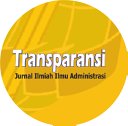An Evaluation of A Government Performance Accountability System Indonesian District Governments 2010
DOI:
https://doi.org/10.31334/trans.v1i1.141Keywords:
The Government, Performance, Accountability System, EvaluationAbstract
The goal of this paper is to provide better information of Government Performance Accountability System (SAKIP) implementation in Indonesian District Governments to policy makers. This study utilizes the evaluation result of Government Performance Accountability System (SAKIP) 2010 to analyze the effort of 273 District governments in Indonesia in implementing the SAKIP.
The research question of this paper is: do auditor’s opinion and number of population have significant different to the SAKIP score? To investigate what factors that determine the score of Government Performance Accountability System (SAKIP), several theories as well as a logical thinking were taken to figure out the research question. Those theories as well as logical thinking reveal that revenue and spending, seize of population, area, poverty level, human development index, auditor’s opinion, number of government employee and education level government employee tend to correlate the SAKIP score.
Two hypotheses have been chosen in this paper: 1) higher level in Auditor’s Opinion more likely will increase the SAKIP score evaluation, and 2) size of Population has significant different to the SAKIP score. Result shows we have to reject all the null hypotheses.
References
Afonso, A., Schuknecht, L., & Tanzi, V. (2003). Public sector efficiency: An international comparison. Working Paper. European Central Bank, Frankfurt, Germany.
Alvin Arens, Loebbecke James. 1980. Auditing, an integrated approach. Prentice-Hall.
Behn, Robert. 2008. Performance Information in the Public Sector: How it is Used.
Blondal, and John, R. 2001, Budgeting in Sweden, in OECD Journal on Budgeting Volume 1 No.1, OECD Publication Service, France
Boyne, G. A., Meier, K. J., O’Toole, L. J., Jr., & Walker, R. M. (Eds). 2006. Public service performance: Perspectives on measurement and management. Cambridge: Cambridge University Press.
Central Bureau of Statistics’s (Biro Pusat Statistik/ BPS) website: (http://www.bps.go.id/tab_sub/view.php?tabel=1&daftar=1&id_subyek=23¬ab=4).
De Lancer Julnes, Patria, and Marc Holzer. 2001. Promoting the Utilization of Performance Measures in Public Organizations: An Empirical Study of Factors Affecting Adoption and Implementation. Public Administration Review 61 (6):693-708.
Directorate General of Financial Balance’s website (http://www.djpk.depkeu.go.id/)
Eckardt, Sebastian. 2008. Political Accountability, Fiscal Conditions and District Government Performance—Cross-Sectional Evidence From Indonesia. Public Administration and Development. 28, 1–17 (2008)
Gene A. Brewer, Yujin Choi, Richard M. Walker, (2008). Linking Accountability, Corruption, and Government Effectiveness in Asia: an Examination of World Bank Governance Indicators. Emerald Group Publishing Limited, pp. 227 – 245
Government Performance and Result Act (GPRA) of 1993 of the United States
Greene, William H. 1990. Econometrics Analysis 2nd edition. Prentice Hall, NJ.
Guidance of SAKIP Evaluation 2010, The Ministry of Bureaucratic Reform
Gujarati, Damodar N. 1995. Basic Econometrics 3rd edition. McGraw-Hill, Inc.
Indonesia Data: http://indonesiadata.co.id/main/index.php
Law number 33 Year 2004 about “Fiscal Balance Between the Central and District Governmentâ€
Minister of Home Affairs Regulation number 13 Year 2006 about “Financial Guidance for Regional Spendingâ€
Munro, Eileen. 2004, The Impact of Audit on Social Work Practice, British Journal of Social Work
President Instruction No.7/1999: Government Performance Accountability System
Sobirun, Ruswadi. 2005. The Development of Government Agency Performance Accountability System in Indonesia. OECD-ASIAN Countries Performance Management Symposium. Seoul.
The Financial and Development Supervisory Agency’s website: http://www.bpkp.go.id
The State Employment Agency’s website: http://www.bkn.go.id
The Supreme Audit’s website: http://www.bpk.go.id
Wooldridge. 2009. Introductory Econometrics: A Modern Approach. 4th edition.
Downloads
Published
Issue
Section
License

This work is licensed under a Creative Commons Attribution-ShareAlike 4.0 International License
Please find the rights and licenses in Transparansi : Jurnal Ilmiah Ilmu Administrasi By submitting the article/manuscript of the article, the author(s) agree with this policy. No specific document sign-off is required.
- License
The commercial use of the article will be governed by the Creative Commons Attribution license as currently displayed on Creative Commons Attribution-ShareAlike 4.0 International License.
2. Author(s)' Warranties
The author warrants that the article is original, written by stated author(s), has not been published before, contains no unlawful statements, does not infringe the rights of others, is subject to copyright that is vested exclusively in the author and free of any third party rights, and that any necessary written permissions to quote from other sources have been obtained by the author(s).
3. User Rights
Transparansi : Jurnal Ilmiah Ilmu Administrasi spirit is to disseminate articles published are as free as possible. Under the Creative Commons license, Transparansi : Jurnal Ilmiah Ilmu Administrasi permits users to copy, distribute, display, and perform the work for non-commercial purposes only. Users will also need to attribute authors and Transparansi : Jurnal Ilmiah Ilmu Administrasi on distributing works in the journal and other media of publications.
4. Co-Authorship
If the article was jointly prepared by more than one author, any authors submitting the manuscript warrants that he/she has been authorized by all co-authors to be agreed on this copyright and license notice (agreement) on their behalf, and agrees to inform his/her co-authors of the terms of this policy. Transparansi : Jurnal Ilmiah Ilmu Administrasi will not be held liable for anything that may arise due to the author(s) internal dispute. Transparansi : Jurnal Ilmiah Ilmu Administrasi will only communicate with the corresponding author.
5. Miscellaneous
Transparansi : Jurnal Ilmiah Ilmu Administrasi will publish the article (or have it published) in the journal if the article’s editorial process is successfully completed. Transparansi : Jurnal Ilmiah Ilmu Administrasi editors may modify the article to a style of punctuation, spelling, capitalization, referencing and usage that deems appropriate. The author acknowledges that the article may be published so that it will be publicly accessible and such access will be free of charge for the readers as mentioned in point 3.
Every accepted manuscript should be accompanied by "Copyright Transfer Agreement"prior to the article publication.











